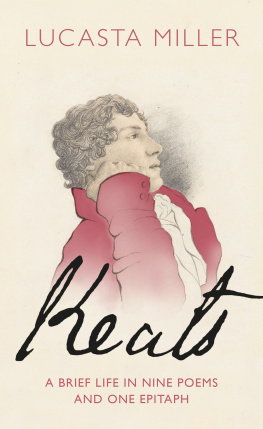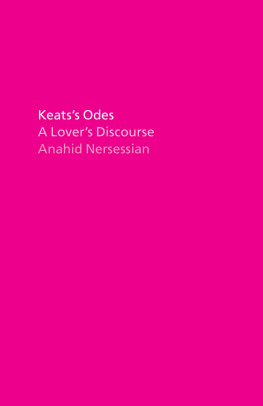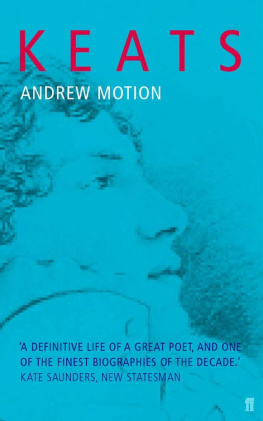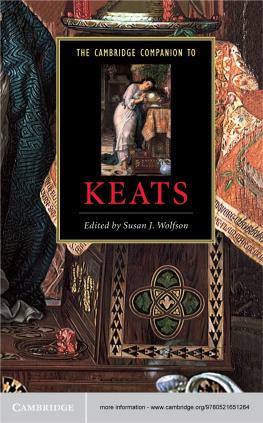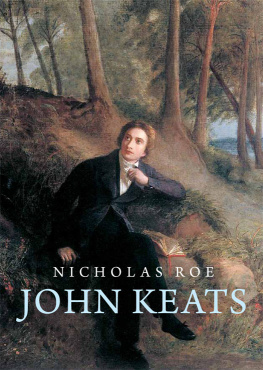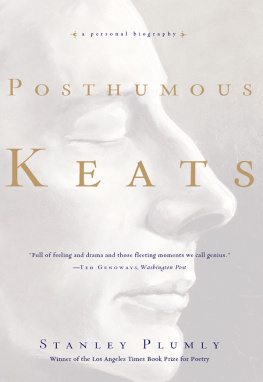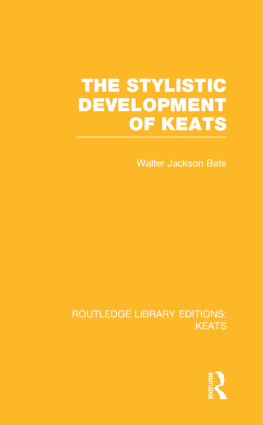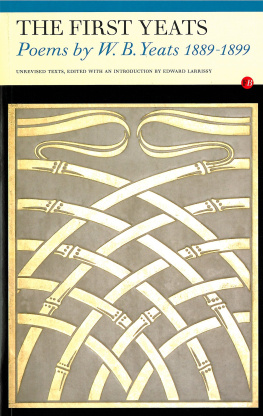Keats and Negative Capability
Bloomsbury Literary Studies Series
Related titles in the series:
Coleridge and German Philosophy, Paul Hamilton
Romanticism, Literature and Philosophy, Simon Swift
Keats and Negative Capability
Li Ou

Bloomsbury Academic
An imprint of Bloomsbury Publishing Plc
50 Bedford Square | 1385 Broadway |
London | New York |
WC1B 3DP | NY 10018 |
UK | USA |
www.bloomsbury.com
Bloomsbury is a registered trade mark of Bloomsbury Publishing Plc
Li Ou, 2009
Li Ou has asserted her right under the Copyright,
Designs and Patents Act, 1988, to be identified as Author of this work.
All rights reserved. No part of this publication may be reproduced or transmitted in any form or by any means, electronic or mechanical, including photocopying, recording, or any information storage or retrieval system, without prior permission in writing from the publishers.
No responsibility for loss caused to any individual or organization acting on or refraining from action as a result of the material in this publication can be accepted by Bloomsbury or the author.
British Library Cataloguing-in-Publication Data
A catalogue record for this book is available from the British Library.
ISBN: HB: 978-1-4411-4724-0
PB: 978-1-4411-8790-1
ePUB: 978-1-4411-0103-7
ePDF: 978-1-4411-7091-0
Library of Congress Cataloging-in-Publication Data
A catalog record for this book is available from the Library of Congress
To
My Parents
Contents
Preface
The term negative capability, used by Keats once only in his letter to his brothers, has become the best known and the most widely adopted phrase of Keatss not only in literary study but in diverse fields quite foreign to literature. For all its popularity and the numerous discussions of it by almost all the major Keatsians since the beginning of the last century, the only book-length study of the idea itself until today is Walter Jackson Bates 1939 monograph published from his Harvard honours thesis. As the most important of Keatss aesthetic ideas, it received most attention in the 1950s and 1960s in accordance with the general trends of literary criticism, after which it became a relatively settled, and thus untended, issue in Keats scholarship. This, however, does not mean that the study of the idea has been exhausted and the state of knowledge has achieved a fully developed level. The annotation to the term provided by The Norton Anthology of English Literature, for instance, was seriously inaccurate, but remained unchanged from the 1962 first edition to the seventh edition published in 2000. Now that about half a century has passed since its heyday in criticism and almost two centuries since it came into existence, the idea calls for a more precise and thorough treatment from a longer historical perspective.
Negative capability is such an essential idea of Keatss that any criticism of him has to deal with it at least in passing. Critics have treated it at various lengths, with different degrees of interest and from diverse perspectives. Yet more often than not, it is discussed as a key issue in the critics overall projects in a bigger framework, be it aesthetic, intellectual, philosophical, stylistic, biographical, ethical, moral, psychological, religious, historical, socio-political, or feminist, while the idea per se rarely constitutes the project itself. Some of these critics have examined the idea at a microscopic level, exploring its meaning, analysing its different aspects, pursuing its convergence with or divergence from other passages in Keatss letters, drawing attention to its inherent complexity, but their study of the idea is still a means serving another end. When the idea does take up the central place in criticism, it is usually found in shorter pieces, which, due to their length, tend to take a rather limited perspective. In consequence, the present state of knowledge concerning negative capability ends up approximately like Lincolns famous saying, with my adaptation: you can find something about the idea in all of the criticisms, and all about the idea in some of the criticisms, but you cannot find all about the idea in all of the criticisms. The broader discussions tend to be cursory, and the closer ones, narrow. This book, therefore, intends to make the idea the end itself, the richness of which argues for its becoming an independent critical field in Keats studies.
Given the nature of this field of knowledge, what I propose is not to open new frontiers, but rather, to till this fertile piece of land which has not yet been thoroughly ploughed. To start with, I shall offer a story of how the phrase was salvaged from obscurity and became known and gradually gained currency, for although the critical heritage of Keatss poetry and prose can be found, we still need a critical heritage of the term itself. The idea itself, like a constellation of several stars, holds together many intricately interrelated components. Again, all these components have been commented upon in various works, but the commentaries are spread out diversely and unevenly, so that all of them become partial views, while the idea is still in want of an overall picture that at the same time does not ignore any of its component parts. To understand the complex structure of this organic idea, we need to analyse how its interlocking ramifications connect with one another and how they compose a whole by all being tied up to a central core. Only by unravelling the key threads of this idea, can we clearly see how its beautiful circuiting weaves into a tapestry empyrean (KL I:232). Similarly, though negative capability has been treated as a key intellectual or aesthetic idea in Keatss poetic evolution, the task of showing whether and, if so, how his poetry embodies and demonstrates the idea has never been taken up as a critical enterprise, which is rather incongruent with the significance critics commonly attach to the idea itself. So is it with the history of the idea. Just as the idea itself holds together many components, negative capability is also part of a cluster of ideas with complex antecedents and successors. Its sources have been either explored or briefly suggested, and many critics, including Shakespeare scholars, have noticed the special importance of King Lear to Keats. What in King Lear gave rise to Keatss thought on negative capability, how King Lear exemplifies this idea and in turn illuminates it, however, have never been given close attention. As for the cultural legacy of the idea, pointing out the link between negative capability and modernist impersonality is no longer a novel idea, but how exactly modernist poetry manifests the heritage of Keatss notion has not been pursued.
All these gaps need to be filled; all the fragments picked up and left randomly need to be assembled meaningfully, so that we can have a full and clear view of the overall pattern of negative capability. This book will, therefore, take a holistic view of the idea by a close study of its history, and by doing so, make the case that negative capability reveals a prominent non-egotistical tradition in English poetry, which can be traced back to Shakespeare and was taken over by Keats, and through Keats, carried on to the modernist poets. As the modernists show, this poetic tradition is itself embedded in a much deeper and wider human tradition, involving not only poetry and aesthetics but also philosophy and religion, one that transcends cultural borders.
Next page


